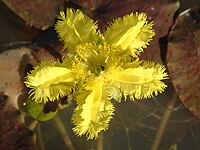bio.wikisort.org - Plant
Nymphoides crenata, commonly known as wavy marshwort, is an aquatic perennial herb of the family Menyanthaceae endemic to Australia,[4] found in all mainland states and the Northern Territory[5][6][7]
| Nymphoides crenata | |
|---|---|
 | |
| Scientific classification | |
| Kingdom: | Plantae |
| Clade: | Tracheophytes |
| Clade: | Angiosperms |
| Clade: | Eudicots |
| Clade: | Asterids |
| Order: | Asterales |
| Family: | Menyanthaceae |
| Genus: | Nymphoides |
| Species: | N. crenata |
| Binomial name | |
| Nymphoides crenata | |
 | |
| Occurrence data from AVH | |
| Synonyms[3] | |
|
Limnanthemum crenatum F.Muell. | |
Description
It is a stoloniferous, floating, perennial with stems up to 3 m long. The petioles of the basal leaves are from 8–42 cm long. The leaf lamina are ovate to circular, and deeply cordate and vary from 3 to 15 cm in length. The stem leaves are smaller, and sometimes kidney-shaped. The flowers heterostylous, (see the gallery) and there can be from 8 to14 in clusters subtended by 1–4 stem leaves, or sometimes in spaced pairs along a short inflorescence. The calyx is from 5.5 to 16 mm long and the corolla from 20 to 50 mm in diameter. There are usually 4 lobes (sometimes 4 or 6) and there are usually 5 stigmas (but from 2-5).[6]
Habitat
It grows on floodplains,[8] in swamps, lagoons, irrigation channels, and also in temporarily inundated depressions,[6] and in slow-flowing streams where the depth of the water is up to about 1.5 m deep, usually on mud, and it will persist on drying mud.[4]
Taxonomy
Nymphoides crenata was first described as Limnanthemum crenatum in 1854 by Ferdinand von Mueller.[1][9] In 1891, Otto Kuntze transferred it to the genus, Nymphoides.[1][2]
Gallery
- leaves & stem
- flooded plain
- floating leaves & stems
- flower
- flower
References
- "Nymphoides crenata". Australian Plant Name Index, IBIS database. Centre for Plant Biodiversity Research, Australian Government.
- Kuntze, C.E.O. (1891). "Nymphoides". Revisio Generum Plantarum. 2: 429.
- "Nymphoides crenata (F.Muell.) Kuntze | Plants of the World Online | Kew Science". Plants of the World Online. Retrieved 2020-06-24.
- Jacobs, S. W. L. "New South Wales Flora Online: Nymphoides crenata". Royal Botanic Gardens & Domain Trust, Sydney, Australia.
- Nymphoides crenata occurrence data from Australasian Virtual Herbarium: WA NT QLD NSW VIC SA
- "Flora of Victoria: Nymphoides crenata". vicflora.rbg.vic.gov.au. Retrieved 2020-06-24.
{{cite web}}: CS1 maint: url-status (link) - Western Australian Herbarium, Biodiversity and Conservation Science. "FloraBase—the Western Australian Flora: Nymphoides crenata". florabase.dpaw.wa.gov.au. Retrieved 2020-06-24.
{{cite web}}: CS1 maint: url-status (link) - "NT Flora: Nymphoides crenata factsheet". eflora.nt.gov.au. Retrieved 2020-06-24.
{{cite web}}: CS1 maint: url-status (link) - Mueller, F.J.H. von (18 September 1854). "Definitions of rare or hitherto undescribed Australian plants, chiefly collected within the boundaries of the colony of Victoria". Transactions of the Philosophical Society of Victoria. 1: 17.
Другой контент может иметь иную лицензию. Перед использованием материалов сайта WikiSort.org внимательно изучите правила лицензирования конкретных элементов наполнения сайта.
WikiSort.org - проект по пересортировке и дополнению контента Википедии





